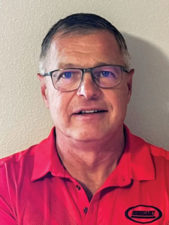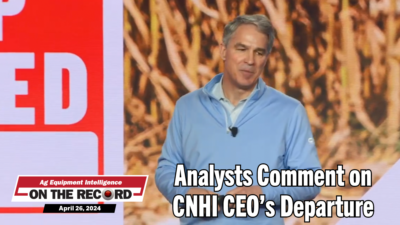Perry Weisberg has been with Bourgault since July 1989 and over the last 30-some years, he’s held various roles — service, sales, marketing and agronomy — with the implement manufacturer. Today, Weisberg is the U.S. marketing leader and in addition to the marketing side of the business, he spends a fair amount of his time on the agronomics as well.
Weisberg says that as a company, Bourgault tries to focus on making its dealer network as profitable and successful as possible. Dealers have certainly taken notice of that commitment. This year Bourgault earned a Gold Level Award in the North American Equipment Dealers Assn.’s annual Dealer-Manufacturer Relations survey and earned the Dealers Choice Award in 2021, 2018 and 2017.
“In some of the dealer-manufacturer surveys out there, it always surfaces that Bourgault does genuinely try to do the best job we can in reaching that objective. I think that’s been a big part of our formula for success in the past, and we look forward to continuing to make that a part of the success of our future,” he says.
When Bourgault is looking to add new dealers, what is it they’re looking for beyond just “this area has a need and an opening?”
Perry Weisberg: The No. 1 thing we do is look for that dealership that has visionary ownership or management. We’re looking for dealers who understand the challenges their customers face and are really looking to supply them with an equipment solution that maybe has not been previously offered or something outside of the box a little bit — something that’s truly going to add to the value that customer sees by making that purchase.
Key to that, too, is knowing and understanding their customer base — who their new buyers are and who their used buyers are, because getting that first generation or second generation trade sold is equally as important as selling the new piece.
With some of the recent enhancements to our product line, we are certainly pushing farther into the traditional corn and soybean areas than we ever have before. And the reason for that is we now have a piece of equipment that is capable of both being a traditional air seeder as well as singulating as a planter would do.
How has the company managed the supply chain issues we’ve been dealing with and also communicated with your dealer network on the issues and when they might start to improve?
Weisberg: Managed might be a strong word here, but I think everyone is quite familiar with the challenges that are out there. There’s a likelihood this could become the new normal.
“You’re not necessarily selling color, you’re selling a value or proposition that probably isn’t going to be on the main line side of the business…”
One of the things that has been particularly challenging for us has been some of the specific tire sizes we use on our larger air seeders. That has been a source of real frustration for us, our dealers and our customers. I think our purchasing team has done a tremendous job of actively scouring the planet for new and alternate suppliers. I think our sales team has been very active in participation with our dealer network in communicating where those areas of tight supply are and what the implications of that are ultimately going be. That has really created a situation for us where we’ve always been able to meet our promised deliveries, not always in the most ideal timeframe, but certainly in a timeframe that meets the season of use.
And then when looking forward to new sales, we’ve been proactive and cautious in how we accept those orders and really only put into our production schedule what we’re reasonably confident we can deliver in the timeframes that are required. We just can’t guarantee anything with 100% confidence at this point.
Did you see an uptick in early orders this year?
Weisberg: Certainly. From my perspective, I think the entire industry has shifted — it’s no longer a matter of picking up the phone and expecting availability to be there. The industry has come to appreciate that if a purchase is being considered, it is going to be a long-term process. Looking forward and planning ahead are essential to making sure that equipment is available when it’s needed and when it’s wanted.
What do dealers need to know about selling Bourgault’s products specifically, but also shortline products in general, and how it differs from selling a product one of the major lines manufacture?
Weisberg: When you have access to a value-added shortline product — I would consider the Bourgault product line to be beyond that scale — they are a real opportunity for a dealer to improve their margins. You’re not necessarily selling color, you’re selling a value or proposition that probably isn’t going to be on the major-line side of the business. That always provides the opportunity for a premium in margins and a premium in the profitability that the dealer can generate by carrying that line. It is a story that is often echoed by many of our dealers.
Looking ahead to the end of this year and then going into 2023, what do you think the biggest challenges are for Bourgault and your dealers?
Weisberg: The No. 1 challenge for customers, for dealers and for us as manufacturers is identifying those solutions that are really needed to generate that incremental revenue generation. And it’s not so much about getting more for less, but really strategically focusing on what tools are needed in the tool bag to take advantage of the opportunities that present themselves.
I think the world is still in a really unprecedented level of change, and just because we think this happened yesterday, tomorrow that pendulum could swing an entirely different direction. I don’t know if there’s a time that I can ever recall where that pendulum has shifted so quickly from one extreme to the other. And really being as prepared as possible to take advantage of whatever opportunity presents itself is the challenge we all face.
Can you share a little bit about Bourgault’s research farm — how it’s used and how that data is shared with either customers or dealers?
Weisberg: The research farm is an approximately 2,500 acre commercial farm. So, it’s big enough to have to pay attention to, but probably small enough to still be able to focus on the details.
“We ... really only put into our production schedule what we’re reasonably confident we can deliver in the timeframes that are required…”
It has been a tremendous asset for our company. We’re able to test out new concepts on the farm, where we’re able to conduct hundreds of replicated trials each year using modern equipment, both to mirror our own products as well as those of our competitors and really understand and appreciate from an agronomic perspective how those little nuances or those differences between the style of product make a difference in yield. We publish all of the data we generate off the farm on our website.
We have a concentrated outreach program by our agronomy team to bring that message both to our dealer network and to their customer base. We try to do that with a focus that drifts away from the machine itself to really what the agronomic challenges are and some of the things that anyone can do to try and improve their yield each and every year.
One of the challenges our dealers face is not all of them necessarily focus on those agronomic challenges their customers face. But those who do really, really stand out and really benefit from having that perspective.
Do you see having that kind of agronomy focus or an agronomist on staff as something dealers are going to need in the future to compete or succeed?
Weisberg: Absolutely. I think looking forward, that need is probably only going to increase. I think the complexity of the issues that are happening and the problems that are being faced on the farm really often can only be addressed by having someone with that expertise or knowledge. Because probably unlike anything else, there’s so many things that a dealer faces. There are so many things farm management face and having somebody they can turn to for answers is so important.








Post a comment
Report Abusive Comment